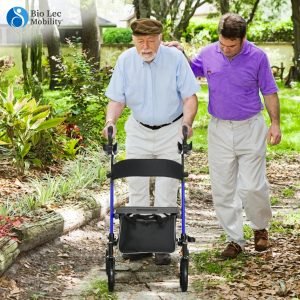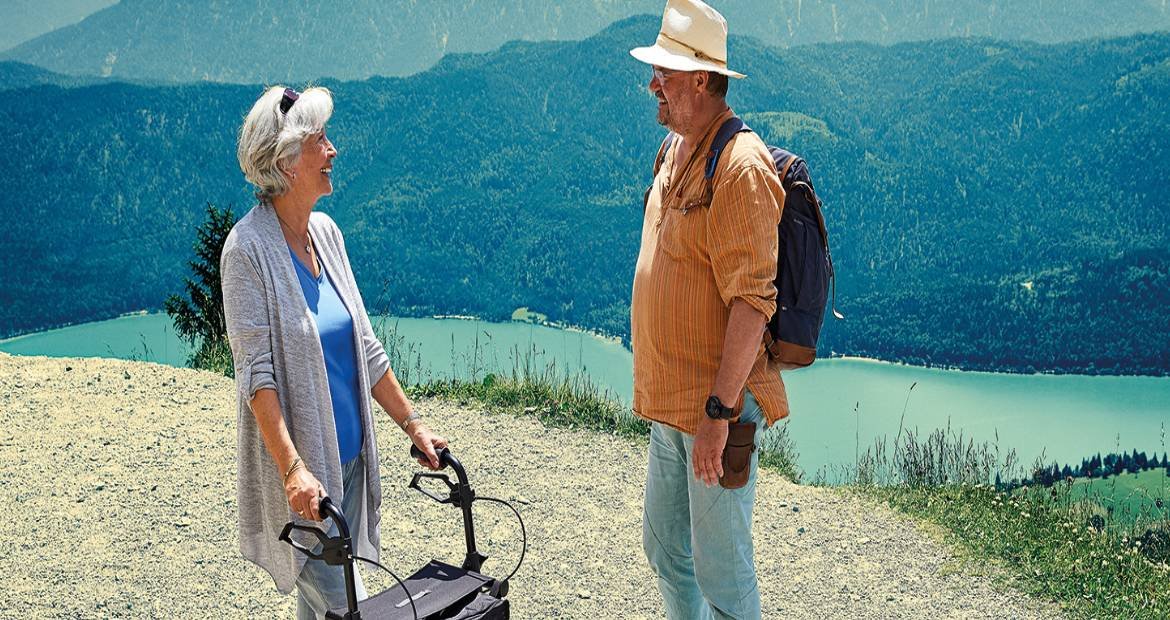Going down a steep hill can be challenging. Here are some tips to help you safely navigate the hill:
-
- Keep your rollator close: Ensure that your rollator is positioned close to your body, with the brakes engaged while walking downhill. This will give you better control and stability, reducing the risk of losing balance and falling.
- Walk slowly and carefully: Take small, slow steps while walking downhill, and try to maintain your balance by keeping your feet close to the ground. Avoid rushing or taking long strides, as this can increase the risk of tripping and falling.
- Use the brakes: Make sure to use the brakes of your rollator to control your speed while walking downhill. To do this, engage the brakes and lean back slightly, allowing the rollator to slow down gradually.
- Watch out for obstacles: Keep an eye out for any obstacles such as rocks, tree roots, or uneven surfaces, which can cause you to trip and fall. Take your time and navigate around them carefully.
- Use a companion: If possible, have someone accompany you while walking downhill, especially if you feel unsure or unsteady. A companion can provide additional support and help you navigate any obstacles.
- Keep your posture upright: Leaning too far forward or backward can throw off your balance while walking downhill. Try to keep your back straight and your posture upright, with your feet positioned shoulder-width apart.
- Look ahead: Keep your head up and look ahead while walking downhill. This will help you anticipate any obstacles or changes in the terrain, allowing you to adjust your pace and stride accordingly.
- Use the terrain to your advantage: If the hill has a gentler slope on one side, try walking on that side as it can help reduce the strain on your rollator. Similarly, if there are switchbacks or zigzag paths, use them to reduce the steepness of the hill.
- Wear appropriate footwear: Make sure you wear comfortable, well-fitting shoes with good traction while walking downhill. This will help you maintain your balance and prevent slipping.
- Practice on a smaller slope: If you’re not used to walking downhill, it may be helpful to practice on a smaller slope first before attempting a steeper one. This will help you build confidence and get used to the technique.

How to slow down a rollator walker ?
-
- Brakes Adjustment: Most rollator walkers come equipped with brakes that allow you to control the speed. Look for brake handles or levers on the walker’s handles or frame. If they are adjustable, you can tighten them to increase resistance and slow down the walker’s movement. Refer to the user manual specific to your rollator walker model for instructions on adjusting the brakes properly.
- Wheel Resistance: Another method is to increase the resistance of the wheels. Rollator walkers typically have four wheels, and some models may allow you to adjust the resistance on one or more of the wheels. Check if your walker has any mechanisms to tighten or loosen the wheels, which can affect the rolling speed.
- Terrain Adaptation: If you’re experiencing difficulty controlling the speed of your rollator walker on certain terrains, consider adapting to the environment. For instance, when going downhill or on slippery surfaces, walk sideways or at an angle to reduce speed and maintain stability. Taking smaller steps can also help control the speed on uneven surfaces.
- Accessories: There are accessories available for rollator walkers that can help in slowing down the walker’s speed. One such accessory is a drag brake or a resistance brake. These attachments add friction to the wheels, making it easier to control the rollator’s speed. You can consult with a healthcare professional or visit a medical supply store to inquire about suitable accessories for your rollator walker.
Remember, everyone is different, and what works for one person may not work for another. It’s essential to listen to your body and go at a pace that feels comfortable and safe for you. If you have any concerns or doubts, it’s always best to consult with your healthcare provider before attempting any new activity.




